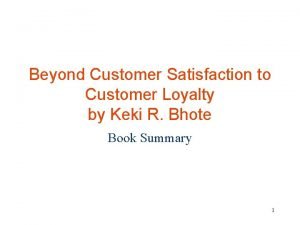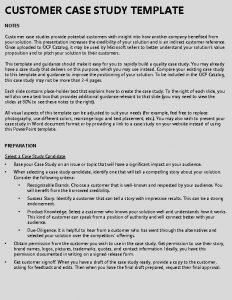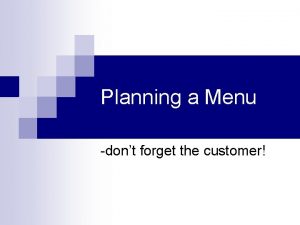Demographics DONT FORGET THE CUSTOMER Demographics the study









- Slides: 9

Demographics -DON’T FORGET THE CUSTOMER!

Demographics the study of People surrounding your business & potential customers within that location This information can be found in three different ways… 1. 2. 3. Feasibility Study – does the business idea make sense? Demographic Survey – find out about your potential customers Personal Knowledge – what do you already know about your customers?

Demographics What do you want to know? Income Age Education Religion Ethnicity Occupation

Demographic Circle 3 Reasons people go out to eat Concepts Convenience Quick Service – Family Social Occasions Dinner House – Mid-Scale Eating Pleasure Fine Dining – Using Different Styles of Service

Psychographics The behavior, values, opinions, cultures, interests and lifestyles of a demographic group. Psychographics can be from credit cards, polls and censuses to analyze different segments of the population. You could also purchase this information from a credit card company. More economical- hang out in the area in order to learn about the people in your area. You can learn a lot about consumers’ needs simply by being around them.

Examples of Psychographics 18 to 24 -year-olds eat out and drink alcohol outside the home more often than other age groups. 1 Generation Y – those born since 1978 – tend to eat more often at quick-service and pizza restaurants. 2 Generation X – those born between 1965 and 1977 – tend to prefer quick-service or casual establishments with comfort and a good perceived value. 3 Smaller households eat out more often than bigger households. 4 Empty nesters eat out more and spend more when they eat out. They typically spend 65% more on dining out than couples living with children. 5 Empty nesters are generally more concerned about the quality of food and the elegance of the atmosphere than the price. 6 People with more income tend to eat out more frequently. 7 People who work long hours eat out more than people who have enough free time to cook their own meals. Working wives tend to prefer eating out more than housewives. 8 Traditionally, the older people get, the less frequently they eat out. 9 However, this may change soon, since many baby boomers grew up eating out often. Seniors tend to eat early and slowly, and they look for good values with small portions. 10 Wealthy, well-traveled consumers, particularly the wealthier baby boomers and the next generation, are more likely to look for ethnic or exotic food when they eat out. 11

Understanding the Customer Once you know and understand your customer, you can target your restaurant concept, theme, and menu to meet their needs. Examples?

Concept Can Determine $$$$ Quick Service / Dinner House / Family Dining Mid-Scale Fine Dining Turnover Rate per Hour 3 -10 Estimated Eating Time 6 -20 min. Turnover Rate per Meal Period 10 -40 times 3 -5 times 2 times Average Sales per Cover (PPA) Low $5 -$15 Med. $15 -$25 High $45 -$100 1 -1. 25 . 5 -. 75 45 -60 min. 60 -150 min.

Hours of Operation Breakfast & Lunch- Must contain speed, simplicity, and variety Dinner- More selection, more service, and higher prices
 Dont ask dont tell political cartoon
Dont ask dont tell political cartoon Dont laugh at me dont call me names
Dont laugh at me dont call me names Dont forget to join
Dont forget to join Despite the data glut that marketing managers
Despite the data glut that marketing managers Customer relationship management and customer intimacy
Customer relationship management and customer intimacy Pengertian customer relationship
Pengertian customer relationship Beyond customer satisfaction to customer loyalty
Beyond customer satisfaction to customer loyalty Customer relationship management and customer intimacy
Customer relationship management and customer intimacy Intimacy
Intimacy Case study notes
Case study notes

















